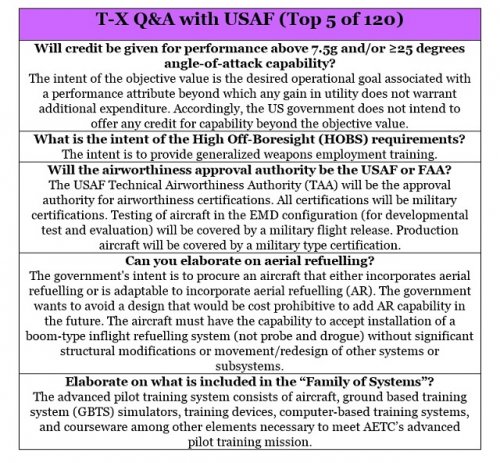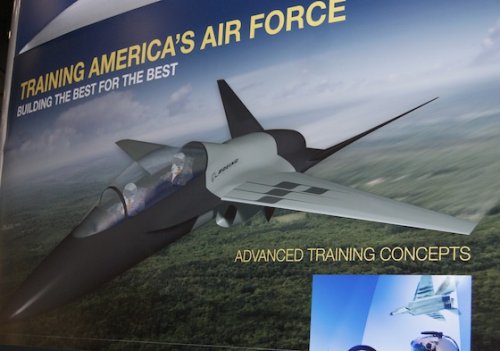bring_it_on
I really should change my personal text
- Joined
- 4 July 2013
- Messages
- 3,203
- Reaction score
- 2,497
T-X: $1 Billion a Year
http://www.airforcemag.com/DRArchive/Pages/2015/March%202015/March%2023%202015/T-X-$1-Billion-a-Year.aspx
No Aggressor, But Built-In Adaptability
http://www.airforcemag.com/DRArchive/Pages/2015/March%202015/March%2023%202015/No-Aggressor,-But-Built-In-Adaptability.aspx
The finalrequirements for the Air Force’s T-X trainer call for a fleet of 350 aircraft and a training system, including simulators and courseware, that can be bought and operated for $1 billion a year for 20 years, in base-year 2014 dollars. A contract is to be let in late 2017. The requirements are being released about 10 months earlier than usual acquisition procedures, meant to generate “more deliberate and open engagement with industry,” said Brig. Gen. Dawn Dunlop, Air Education and Training Command director of programs and requirements. Initial draft requirements were released in 2012. The jets will replace about 420 T-38s, which are now more than 50 years old. According to AETC, the period of operation for T-X is 2026-2045, with first deliveries due in 2022. The aircraft are to fly 360 hours a year, at a mission readiness rate of 80 percent. AETC has not limited the competition to “off the shelf” aircraft, and contractors are free to submit clean-sheet designs. Boeing and Northrop Grumman each are designing new jets for the T-X competition, and Lockheed Martin has a new design ready in case its offering of the Korean T-50 trainer, which it helped develop, doesn’t meet the requirements.
http://www.airforcemag.com/DRArchive/Pages/2015/March%202015/March%2023%202015/T-X-$1-Billion-a-Year.aspx
No Aggressor, But Built-In Adaptability
The requirements for the Air Force’s T-X trainer don’t call for the airplane to be capable of the aggressor mission, but the jet is to have sufficient space, weight, power, and cooling to accommodate that role in the future. Lt. Gen Tod Wolters, deputy chief of staff for operations, told the Senate Armed Services airland panel on March 19 that it’s “too early” to look at the T-X for the aggressor role, noting F-16s are doing the mission “most cost effectively” for the near-term. However, USAF may want to consider the T-X in the aggressor role “at some point.” William LaPlante, service acquisition executive, said USAF ensured the requirements didn’t “limit our options” regarding future T-X applications. Air Education and Training Command said March 20 there is $40 million across the future years defense plan under “stores-aircraft interface” “to provide future planning or development options related to T-X.” Gen. Robin Rand, AETC commander, said a T-X variant “is just one option for ‘Red Air’ if we decide there’s a requirement for it.” (LaPlante/Holmes prepared testimony)
http://www.airforcemag.com/DRArchive/Pages/2015/March%202015/March%2023%202015/No-Aggressor,-But-Built-In-Adaptability.aspx


